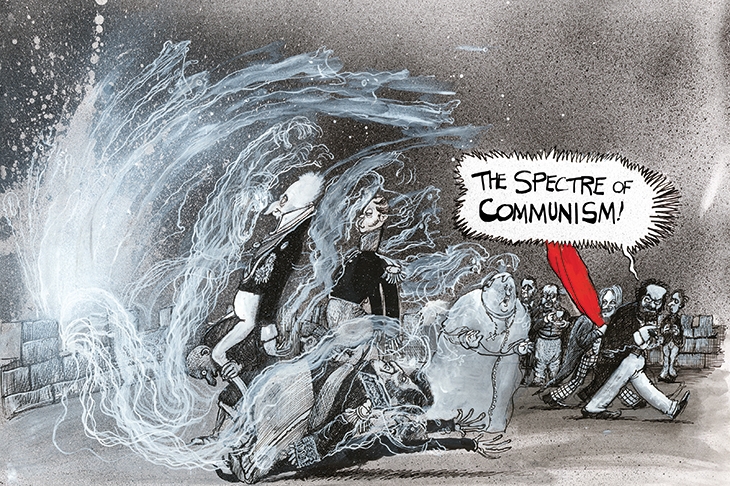Its Booker-longlist nomination meant that Nick Drnaso’s Sabrina (Granta, £16.99) was the comic that everyone has heard of this year, even if it’s also the one most likely to give them post-traumatic stress. Drawn in deliberately bland colours and small, often wordless panels, this story about the human aftermath of a grisly American killing takes in internet paranoia, conspiracy theorists and the internet’s hyperspeed appetite for atrocity. But it’s also an intensely withdrawn book, full of desperate characters whose emotions vibrate at near-subperceptible frequencies. I admired it deeply, and I’d be happy never to think about it again.
Less emotionally stressful, though with deep seriousness lurking beneath its shrewd wit and artistic energy, is Jules Feiffer’s The Ghost Script (Liveright, £19.99), the third in a trilogy of graphic novels by a veteran cartoon satirist (Feiffer is 89). In straggly, super-vivid monotone art, it pays homage to the Spirit comics of Will Eisner, whom Feiffer once assisted, and the PI stories of mid-century Hollywood. This final volume ties up the loose ends of its predecessors, offering closure to some and a sticky end to others, as a bunch of detectives, commie screenwriters, gossip-mongers, starlets and right-wing agitators hare about after a dynamite screenplay that may or may not exist.
On the topic of commies, I’ve enjoyed few comics this year as much as Martin Rowson’s slim, ferocious retelling of Marx and Engels’s The Communist Manifesto (SelfMadeHero, £12.99). Published for the 200th anniversary of Marx’s birth in a deft abridgement with introductory notes by Rowson, this is a nightmare fantasia in black, grey and, naturally, red, in which grisly industrial landscapes are stalked by toilet-bowl monsters with cash registers for heads and a huge iron giant of industry with the face of the Westminster clock.
Like all Rowson’s stuff, it’s extraordinarily clever and utterly savage: I didn’t know whether to squeal with laughter or horror at, for example, the drawing of the proletariat getting its tongue caught in a mangle, then being snipped up and pulped by wing-collared Lord Snooties, or the riot policeman shining a torch down an old lady’s throat beneath the iron cliff of a bank’s HQ. In some ways it’s the perfect Spectator stocking-filler.
The Manifesto wasn’t the only historic work freely adapted as a comic this year. Anne Frank’s Diary: The Graphic Adaptation (Penguin, £14.99) offers a version of the text endorsed by the Anne Frank Fonds, and presented in graphic form by Ari Folman and David Polonsky, the Israel-based director and artist behind the animated film Waltz with Bashir. This English version is late to market, but it’s still a treat, with Folman’s scripting a marvel of compression and Polonsky’s supple, witty art tracking Anne’s mind through banality, reflection, fantasies and nightmares. It’s one to read and share.
As is Ken Krimstein’s The Three Escapes of Hannah Arendt (Bloomsbury, £14.99), a spirited biographical comic about the inner life of the German philosopher and social/political theorist: her life in Berlin, her escape from France, her philosophical development and her relationship with Heidegger. Told in a quirky style that may lure readers fascinated by a previous struggle against patriarchy, anti-Semitism and the extreme right, it’s forested with footnotes (initially infuriating, then quite endearing) that will whisk even the staunchest anti-Wikipedian through the whole thing: Auden, Augustine, Husserl, Horkheimer, Schnabel, Schoenberg, Onkel Tom Kobli and all.
And a small but special mention for Apollo (SelfMadeHero, £15.99), a comic by Mike Collins, Matt Fitch and Chris Baker that spins outward from the central event of the Moon mission into the lives of astronauts, families, politicians and the world, without ever falling into clichéd heroics or losing its poise and sense of character, making a familiar story thrilling and wondrous again.
The tide of graphic memoirs in comics has slackened these days, but superb examples still crop up. One of the finest is Riad Satouf’s ongoing Arab of the Future series (Two Roads, £18.99), whose third volume picks up with the author, aged six, in a small Syrian town, struggling to interpret the relationship between his French mother and Syrian father and wrap his head round the ethics of circumcision and the exhaustions of Ramadan, not to mention how Father Christmas and Conan the Barbarian fit in with Allah and Christ. It’s expressively drawn, superbly observed and just the right amount of uneasy fun.
I was also hugely taken by Nora Krug’s Heimat (Particular Books, £22), a beautifully produced and thoughtful piece of family history by a second-generation German immigrant to the US. Deeply memorable are her illustrations of the notebooks written by her uncle, aged 11, in which the assignment titles move swiftly from ‘How I Honoured My Darling Mother’ to ‘The Jew, a Poisonous Mushroom’.

From Posy Simmond’s Cassandra Darke, a piercing portrayal of contemporary London
Equally worthwhile was Cassandra Darke (Cape, £16.99), the latest skewer-sharp offering from Posy Simmonds. With its shrewd, precise portraits of contemporary London, from the deserted neighbourhoods of the ultra-wealthy to the railway arches of the East End and the jostling crowds on Oxford Street, this piercing story about treachery, fraud, end-life disappointment, human trafficking and bad art confirms me in the belief that I’d rather read her on London than almost anyone else living. The Cassandra of the title is one of her most savoury creations, an elderly, foul-mouthed, dishonest, absurdly rich and entirely unshockable gallery owner, who elicits our sympathy as much as our horror as she is whisked into gangland confrontations, court cases and the life of a woman several decades her junior.
Not a comic, but undoubtedly one of the great books of the year is the Cambridge History of the Graphic Novel (CUP, £125), a fabulously learned volume containing essays on everything from Little Nemo and The Silver Surfer to punk comics, Joe Sacco, LGBTQ comics and ‘E-Graphic Novels’. It feels appropriately weighty reading now that the is-it-art debate has moved on to video games and no one looks askance at one for reading funny books on the bus.
But sometimes it’s still good to be made aware of just how subversive and mindwarping comics can be. And while the crowded, deep-pocketed, frequently reactionary field of superhero comics isn’t always the best place to look for evidence, Al Ewing’s You Are Deadpool (Panini/Marvel, £11.99), which turned the fourth-wall-breaking story of Marvel’s unrepentant mercenary into a choose-your-own-adventure game, certainly was. Since Deadpool already knows he’s in a comic, the result, as readers skip about from frame to frame being hectored by the protagonist, is mindwarping as well as extremely jolly.
As is Bizarre Romance (Cape, £20), a collaboration between Audrey Niffenegger and Eddie Campbell, who (they tell us) pursued their own bizarre romance between Chicago and Australia for several years before getting married. This book of short tales, written by Audrey and illustrated by Eddie, bristles with strangeness, from the man whose attic gets ‘infested with angels’ to the woman who pronounces herself ‘Queen RoseRedSnowRidingBeautyShoesHoodSleeping White’ and is promptly sucked into a mirror-world fairy tale.
But the book I keep going back to for its peerlessly haunting art if not its depressed-cyberpunk vision of a future Britain, is Anna Mill’s and Luke Jones’s Square Eyes (Cape, £18.99), about a damaged whizz-kid inventor adrift in a future where social networks have become society itself. The plot will not seem fearsomely novel to sci-fi-watchers, but Mill’s art truly is: it’s utterly confident and audacious in its space, aesthetics, innovation and design, and I could page through it from now until next Christmas with the same sense of wonder. A thing of beauty, indeed.






Comments